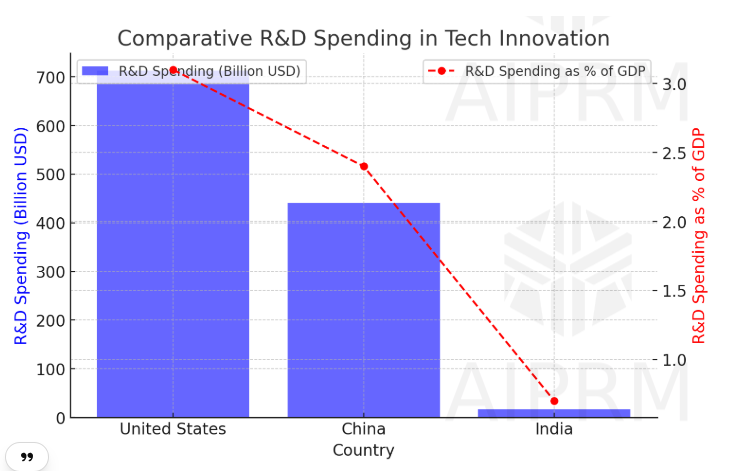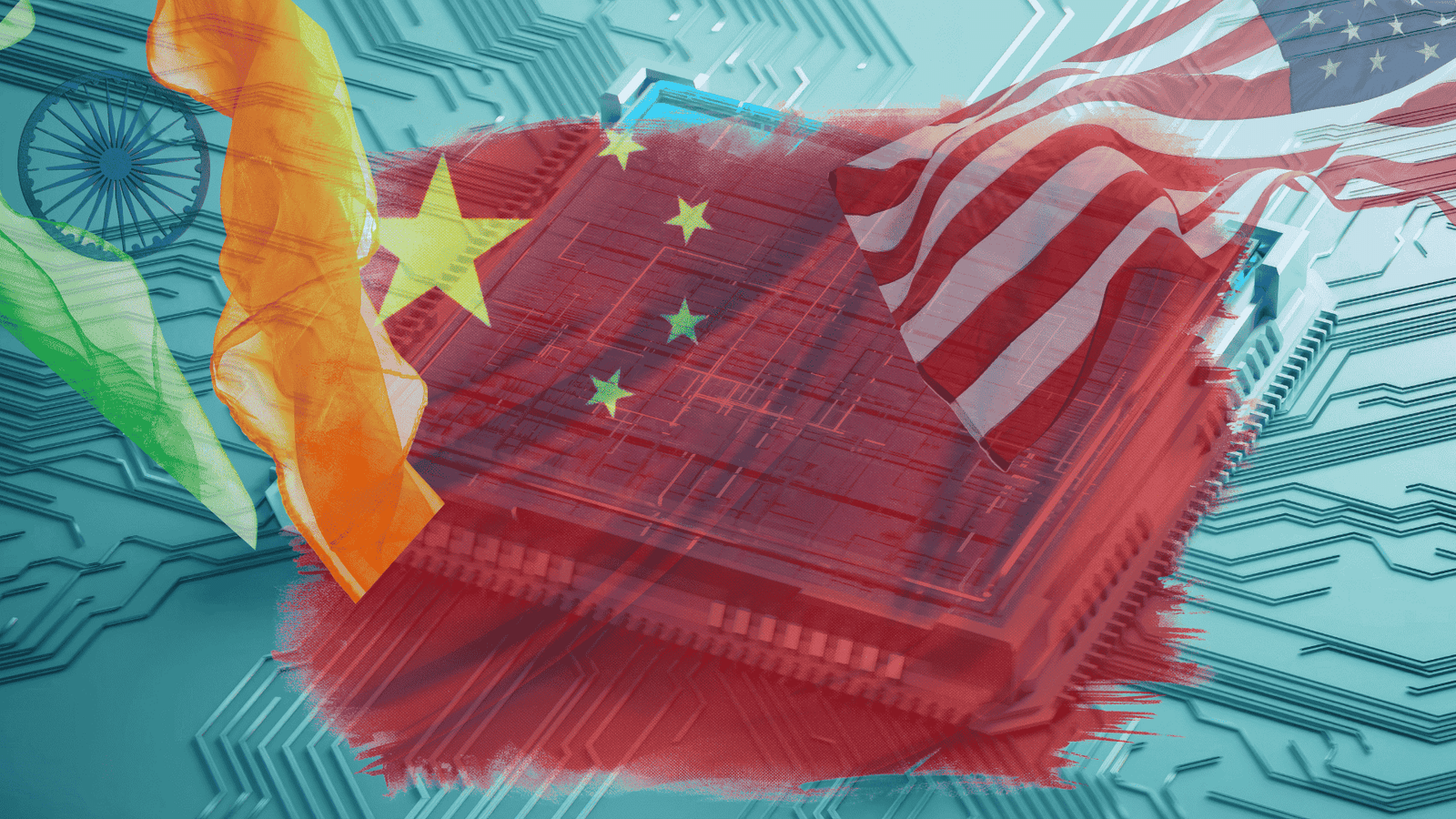Deep Dive To Deepseek : A comprehensive analysis
The global technology landscape is shaped by three major players: the United States, China, and India. While the U.S. has long been the undisputed leader in technological advancements, China is rapidly closing the gap, and India is emerging as a key contender. This comparative analysis explores their strengths, challenges, and strategic approaches across crucial technological sectors.
1. Research and Development (R&D) Investment
United States:
- The U.S. leads in R&D spending, investing $713 billion in 2022, approximately 3.1% of its GDP.
- Tech giants like Google, Apple, and Microsoft drive innovation with significant private-sector contributions.
- Government initiatives such as the CHIPS and Science Act (2022) aim to bolster domestic semiconductor production and advanced research.
China:
- China’s R&D expenditure reached $441 billion in 2022, accounting for 2.4% of its GDP.
- The “Made in China 2025” strategy focuses on achieving self-sufficiency in critical technologies like semiconductors, AI, and 5G.
- China’s R&D growth rate is among the highest globally, emphasizing reduced reliance on foreign technology.
India:
- India lags behind with 0.7% of GDP ($17 billion in 2022) allocated to R&D.
- Although strong in IT services, investment in AI, quantum computing, and semiconductors remains low.
- The National AI Strategy and Semiconductor Mission are steps toward boosting R&D.
| Country | R&D Spending (Billion USD) | R&D Spending as % of GDP |
|---|---|---|
| United States | 713 | 3.1% |
| China | 441 | 2.4% |
| India | 17 | 0.7% |

Comparison:
- The U.S. leads in absolute R&D spending and innovation output.
- China is catching up with aggressive investments and state-backed initiatives.
- India’s low R&D spending is a limitation, but policy shifts indicate a growing focus on innovation.
2. Artificial Intelligence (AI) Advancements
United States:
- Home to AI leaders like Google, Microsoft, and OpenAI.
- AI applications dominate in healthcare, autonomous vehicles, and NLP (e.g., ChatGPT).
- The National AI Initiative ensures continued AI leadership.
China:
- Aims to lead AI globally by 2030.
- Companies like Baidu, Alibaba, and Tencent focus on AI in facial recognition, surveillance, and smart cities.
- State-driven AI development integrates AI into national security and governance.
India:
- Emerging as a significant AI player, leveraging its IT talent pool.
- National AI Strategy prioritizes AI for healthcare, agriculture, and education.
- Startups like Niki.ai and CropIn are developing localized AI solutions.
Comparison:
- The U.S. leads in AI research and commercialization.
- China is advancing rapidly with strong state-driven applications.
- India focuses on AI for social impact but lacks scale and investment compared to the U.S. and China.

3. Semiconductor Industry
United States:
- Dominates 47% of the global semiconductor market.
- Companies like Intel, NVIDIA, and Qualcomm lead in chip design and manufacturing.
- The CHIPS and Science Act aims to reduce reliance on Asian manufacturing.
China:
- Largest semiconductor consumer, importing $400 billion annually.
- Investing $150 billion over the next decade to build self-sufficiency.
- Faces hurdles due to U.S. export restrictions on advanced chips.
India:
- Imports 95% of semiconductors, highly dependent on foreign suppliers.
- The $10 billion Semiconductor Mission seeks to attract global manufacturers.
- Focus on chip design and assembly, leveraging IT talent.
Comparison:
- The U.S. leads in semiconductor design and innovation.
- China is investing heavily but struggles with advanced production due to U.S. sanctions.
- India is a late entrant but has potential in chip design and assembly.
4. The Rise of DeepSeek: China’s AI Disruptor
Founded in 2023 by Liang Wenfeng, DeepSeek has challenged U.S. dominance in AI. Its flagship model, DeepSeek-R1, rivals GPT-4 but is more cost-efficient. Trained using 2,000 Nvidia H800 GPUs over 55 days, DeepSeek-R1 cost only $5.58 million, compared to $100 million spent by U.S. firms. Innovations like Multi-head Latent Attention (MLA) and Mixture-of-Experts (MoE) reduce memory use and optimize performance.
DeepSeek’s impact includes:
- Highlighting China’s ability to innovate despite U.S. chip sanctions.
- Driving significant U.S. stock market reactions, including Nvidia’s decline.
- Sparking debates over a potential “AI Sputnik moment”, shifting global AI power balances.
5. India’s Position Amidst U.S.-China Rivalry
India has seen remarkable AI growth, ranking 14th globally in AI research. However, it contributes only 1.4% of AI research papers, compared to 30.4% (U.S.) and 22.8% (China). However, India leads globally in AI skill penetration, scoring 2.8, ahead of the U.S. (2.2) and Germany (1.9). The country’s AI talent concentration has grown by 263% since 2016.
Government and private initiatives strengthening India’s AI ecosystem:
- NASSCOM’s Centers of Excellence foster AI innovation.
- Digital India Bhashini Project democratizes AI in regional languages.
- JioBrain (Mukesh Ambani’s AI initiative) revolutionizes AI applications in telecom and energy.
- India’s AI services market is projected to be worth $17 billion by 2027.
Conclusion: The Future of Global Tech Leadership
The United States maintains its lead in innovation, AI, and semiconductors, supported by private-sector strength and research institutions. China is closing the gap with state-driven initiatives and strategic investments, particularly in AI and 5G. India, while behind in R&D and infrastructure, is leveraging its vast talent pool and startup ecosystem to carve a niche in IT, AI services, and semiconductor assembly.
As DeepSeek disrupts traditional AI development and U.S.-China tech tensions escalate, India’s evolving tech ecosystem positions it as a potential bridge between the two superpowers. With increased investments, policy support, and industry collaborations, India has the opportunity to emerge as a global innovation hub. The race for tech supremacy is far from over, and the next decade will determine which nation secures a dominant position in the world’s digital future.
Sources : Forbes.com, ft.com






